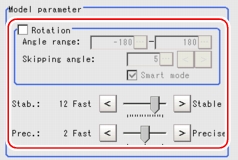[Model (3D Search)]
- 'Registered model image' refers to the image saved when a model is registered. Saving a registered model image allows you to modify model parameters using that registered model image even when the actual measurement object is not present. Note that the scene data size increases when a registered model image is saved.
For the subsequent operations, see  Setting up [3D Search].
Setting up [3D Search].
Changing Model Parameters
When any settings have been changed, verify whether measurements can be performed correctly through actual measurement.
- For of search operations, see
 User's Manual, "Configuring Search".
User's Manual, "Configuring Search".
- In the "Model parameter" area, specify a value for each item.
- If necessary, check "Rotation" and specify a value for each rotation item.How to input a value:
 User's Manual, "Inputting a Value"
User's Manual, "Inputting a Value" - The values for "Stab." and "Prec." can be specified by dragging the slider.
- If necessary, check "Rotation" and specify a value for each rotation item.
Points on Adjustment
For adjustments, see also  User's Manual, "Points on Adjustment".
User's Manual, "Points on Adjustment".
When measurement results are unstable
- If the model image consists of detailed figures, specify a larger value for "Stab.".
- If images that should be judged OK based on the model image vary in some degree, specify a smaller value for "Candidate LV".
- If the measurement results are unstable only when [Rotation] is selected, specify a smaller value for "Skipping angle".
- When "Rotation" is selected, if the model region shape is complex, uncheck the "Smart mode" option.
When the processing speed is slow
- If the model image is a simple figure or a large figure, specify a smaller value for "Stab.".
- If images that should be judged OK based on the model image have less variation, specify a larger value for "Candidate LV".
- When "Rotation" is selected and the model image is a simple figure, specify a larger value for "Skipping angle".
- When "Rotation" is selected and the model region shape is simple, check the "Smart mode" option.
For other adjustment methods, see  User's Manual, "Shortening Measurement Time by Setting Processing Item".
User's Manual, "Shortening Measurement Time by Setting Processing Item".


